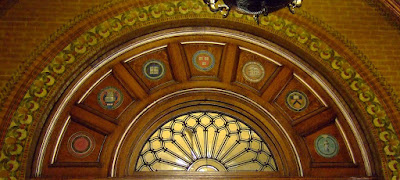 |
| From June 2011 |
Last week, my mom and I had a lovely time visiting two Morris County museums, the one profiled in this post and the Morris Museum, where she's a member. (We also enjoyed a very tasty lunch at the newly re-opened Sirin Thai restaurant.) We hadn't originally planned to visit the trades and crafts museum, but we usually pass the building, so we decided to visit this time.
The Museum of Early Trades & Crafts started as a way for Edgar and Agnes Land, who lived in Madison and collected thousands of 18th and 19th century objects, to share their collections and educate people about the lives of the early artisans, craftspeople, and farmers in New Jersey. The building housing the museum is nothing short of gorgeous. It is often mistaken for a church, but carved into the stone over the entryway is the word "Library."
 |
| From June 2011 |
Opened on Memorial Day 1900, the Madison Free Public Library was a gift to the town from D. Willis James, a wealthy New York (originally from Liverpool, England) industrial capitalist. James had a summer estate in Madison, now known Giralda Farms (you may know it as the estate of Geraldine Rockefeller Dodge). We need another James today. He was so invested in the financial well-being of the library that he set up a trust fund for it based in the income raised from a commercial building he owned across the street from the library.
In the photo above, you can see one of the many beautiful architectural elements of the building. The archway to the Trustee Room shows seven seals from some of America's earliest colleges. Included are Queen's College (later Rutgers College, and eventually Rutgers, The State University of New Jersey), University of Pennsylvania, Yale University, Harvard University, College of William and Mary, Princeton University, and Columbia University. Above the wood with the embedded seals you can see hand-painted designs that continue throughout the building.
Below is an example of a painted column.
 |
| From June 2011 |
In each room with stained-glass windows are beautiful glass-art medallions or plaques within the windows that display inspirational quotations. I can only imagine how stirring it must have been to have sat in the building when it was a library, surrounded by all of the grandeur. It made me a wee bit jealous of the folks who have the good fortune of working in it today.
Below are just a few of those windows that I photographed while walking around the exhibits.
 |
| From June 2011 |
 |
| From June 2011 |
 |
| From June 2011 |
 |
| From June 2011 |
 |
| From June 2011 |
As we explored the building, I was particularly impressed by the main exhibit "Mariners, Merchants, & Pirates." The clever curators use mock magnifying glasses to spotlight items found at the port of Perth Amboy. They also use rope to frame educational materials. It is one of the niftiest exhibits I've seen.
 |
| From June 2011 |
In the exhibit, there is a wealth of information about the tools sailors used to navigate, keep time, build ships, and generally do their work. There also are facts on pirates and privateers (separated only in category by a legal agreement). The exhibit will be featured at the museum until September 4, so add a visit to your summer calendar.
If you can't make it now, the museum has permanent exhibits and changing exhibits, as well as a research library worth exploring if you're interested trades and crafts topics. The permanent exhibits show how craftsmen and artisans created everyday objects like barrels, shoes, cabinets, and more. There also are exhibits on printing (complete with a large press) and other trades.
For more information and to plan your visit, contact the very nice folks at the Museum of Early Trades & Crafts.







